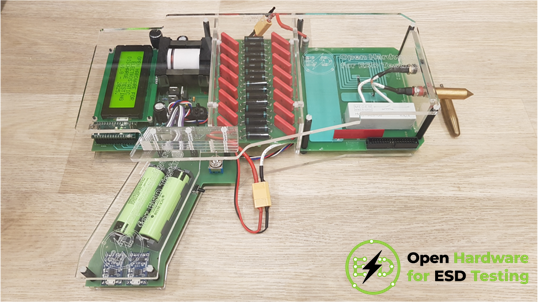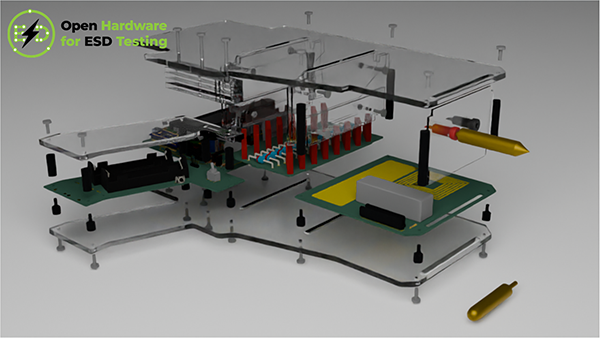O-ESD: Open-hardware for
ElectroStatic Discharge testing
The goals of the Open-hardware for ElectroStatic Discharge testing (O-ESD) are to design, produce and verify an open-hardware and accompanying open-software for a device for electrostatic discharge testing. Electrostatic discharge is a phenomenon that occurs daily between humans and electronics and can irreversibly damage the electronics. All consumer electronics sold in EU, including all internet hardware, must satisfy Electromagnetic Compatibility (EMC) Directive. One of the hardest tests within EMC directive deals with electrostatic discharge as defined by IEC/EN 61000-4-2 standard. Standardized tests are typically done with special equipment in accredited EMC laboratories and are costly. The O-ESD tester will minimize the costs of pre-compliance testing and make it publicly available.
Status
The current status of the project: Version 1.0 is released.
Initial developement ended in May 2025. The O-ESD v1.0 is being used and tested.
Features
- Contact discharge mode and air discharge mode.
- Both positive and negative polarity of the output voltages for all levels.
- Open-circuit output voltage at terminals from 1 kV to 8 kV for the contact discharge.
- Open-circuit output voltage at terminals from 1 kV to 15 kV for the air discharge.
- Single-discharge mode and user-defined pulse repetition.
- User-defined hold time for output voltage for air discharge.
- Equivalent capacitance seen from the output terminals 150 pF.
- Equivalent resistance seen from the output terminals 330 Ω.
- ESD pulse in accordance with IEC/EN 61000-4-2.
- ESD pulse energy up to 17 mJ.
- Powered by two 18650 3.7 V Li-Ion rechargeable batteries.
- 15 hours of continuous operation (using fully charged 3200 mAh batteries).
License
O-ESD is released under CERN Open Hardware License Version 2 - Strongly Reciprocal.
Permissions are granted for: private use, commercial use, modification, distribution and patent use.
O-ESD is provided "as is" with no liability and no warranty of any kind.
Conditions of use: provide license and copyright notice, state changes, disclose source and use the same license.
Documents
For technical information and project progress, check O-ESD documentation on ReadTheDocs.
The raw documents can be found in our self-hosted (Forgejo) git repository.
The developement team can be reached at o-esd@etf.bg.ac.rs.
Acknowledgment
This project was funded through the NGI0 Core Fund, a fund established by NLnet with financial support from the European Commission's Next Generation Internet programme, under the aegis of DG Communications Networks, Content and Technology under grant agreement No 101092990.
Hosted by School of Electrical Engineering, University of Belgrade, since 2024.






